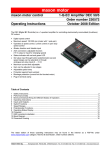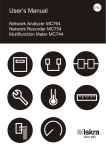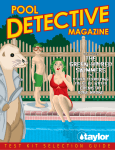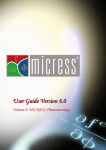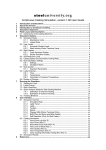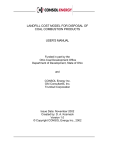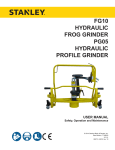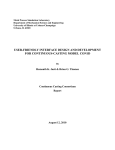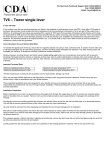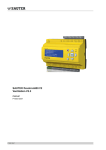Download steeluniversity.org
Transcript
s t e e l u n i v e r s i t y. o r g Electric Arc Furnace Simulation User Guide Version 1 1 2 3 4 5 6 7 8 9 10 Introduction and Disclaimer.............................................................................2 Introduction to Electric Arc Furnace Steelmaking ..............................................2 2.1 Basic Concepts............................................................................................................. 2 2.2 Heating and Melting...................................................................................................... 2 2.3 Other Operational Considerations ............................................................................... 3 Simulation Objectives .....................................................................................3 Simulation Options .........................................................................................3 4.1 Simulation Speed ......................................................................................................... 3 4.2 Target Steel Grade ....................................................................................................... 3 Planning Your Schedule ..................................................................................4 Scrap Preparation...........................................................................................5 6.1 Scrap Selection..............................................................................................................5 6.1.1 User interface .................................................................................................. 6 6.2 Loading Scrap in Baskets .............................................................................................7 6.2.1 User interface .................................................................................................. 8 Furnace Operation ..........................................................................................9 7.1 Loading the Furnace .................................................................................................... 9 7.2 Electrodes ..................................................................................................................... 9 7.3 Power Tap Settings .....................................................................................................10 7.4 Water Cooling Panels..................................................................................................10 7.5 Additions ...................................................................................................................... 11 7.6 Melting and Refining.................................................................................................... 11 7.6.1 Slag Forming Additions .................................................................................. 11 7.6.2 Carbon and Oxygen Injection ........................................................................12 7.6.3 Removal of Phosphorus and Sulfur ...............................................................12 7.7 Tapping ........................................................................................................................12 7.8 User Interface .............................................................................................................. 13 7.9 Keyboard Shortcuts .....................................................................................................14 7.9.1 Add Alloying Material (key A).........................................................................14 7.9.2 View Event Log (Key E) .................................................................................14 7.9.3 Review Analysis (Key R)................................................................................14 7.9.4 Close Dialogue Box (Key X) .......................................................................... 15 Summary of Results...................................................................................... 15 Underlying Scientific Relationships ................................................................ 15 9.1 Temperature ................................................................................................................ 15 9.2 Important Reactions ....................................................................................................16 9.3 Calculating Alloy Additions..........................................................................................16 9.3.1 Calculating Additions to Achieve Aim Composition ......................................16 9.4 Deoxidation .................................................................................................................. 17 9.4.1 Calculating Al additions..................................................................................19 9.5 Foaming Slag.............................................................................................................. 20 9.6 Desulfurization .............................................................................................................21 9.7 Removal of Phosphorus ............................................................................................. 23 Bibliography ................................................................................................23 steeluniversity.org Electric Arc Furnace Simulation User Manual 1 Introduction and Disclaimer This document has been prepared as a user guide to the electric arc furnace simulation, available at http://www.steeluniversity.org/. The interactive simulation has been designed as an educational and training tool for both students of ferrous metallurgy and for steel industry employees. The information contained both in this document and within the associated website is provided in good faith but no warranty, representation, statement or undertaking is given either regarding such information or regarding any information in any other website connected with this website through any hypertext or other links (including any warranty, representation, statement or undertaking that any information or the use of any such information either in this website or any other website complies with any local or national laws or the requirements of any regulatory or statutory bodies) and warranty, representation, statement or undertaking whatsoever that may be implied by statute, custom or otherwise is hereby expressly excluded. The use of any information in this document is entirely at the risk of the user. Under no circumstances shall the International Iron and Steel Institute, The University of Liverpool or their partners be liable for any costs, losses, expenses or damages (whether direct or indirect, consequential, special, economic or financial including any losses of profits) whatsoever that may be incurred through the use of any information contained in this document. Nothing contained in this document shall be deemed to be either any advice of a technical or financial nature to act or not to act in any way. 2 Introduction to Electric Arc Furnace Steelmaking 2.1 Basic Concepts The Electric Arc Furnace (EAF) is today the most common way to recycle steel from scrap. There is a broad variety of steel scrap, both in terms of composition (from plain carbon steel through to highly alloyed tool steel) and geometry (from finely shredded sheet through to large beams). By melting the scrap in a furnace with the help of electrodes and an electrical current, new, functional steel can be produced from old products. Instead of deploying raw material resources, basic steel elements and valuable alloys can be reused, which is beneficial from both an economic and environmental point of view. 2.2 Heating and Melting The heat required to melt steel scrap is provided by electric arcs, created between the electrodes and scrap in the furnace. The electrical power of normal EAFs lies in the range of 50-120 MW, depending on the size of the furnace. Melting of the scrap occurs at a temperature range of 1500-1550°C, depending upon the composition of the steel scrap. After the scrap has been melted, the temperature is normally increased so that refining reactions can be carried out. Oxygen and carbon may be injected into the steel and slag phases respectively. However, the reactions can also create products which are detrimental to the steel quality and which therefore need to be handled carefully. To do that, a slag is formed with the help of slag forming agents, such as lime, dolomite and fluorspar. Slag, having a lower density than steel, normally floats on the steel surface. In addition to absorbing impurities from the steel, the slag also protects the steel from the atmosphere. Furthermore, it protects the furnace walls from the arcs, thereby increasing the electrical efficiency. It is therefore of great importance to maintain a high slag quality and provide it with foaming properties (see Section 0). © 2006 The University of Liverpool 2 steeluniversity.org Electric Arc Furnace Simulation User Manual Once the scrap has been melted and refined to the desired composition and temperature, the contents are tapped into a ladle for secondary treatment and casting. Tapping can either be via a spout, or through a taphole positioned at the bottom of the furnace. 2.3 Other Operational Considerations At first glance, the basic processes of the EAF appear quite straightforward – simply providing enough electrical energy to heat and melt the steel scrap. However, the whole process takes place under conditions of extreme temperature, which complicate maintenance of the furnace, and the correction of any problems. For example, to preserve the refractory lining in the vessel, water cooling panels are built-in in the furnace walls. Without careful control, these can overheat and the process temperature has to be adjusted accordingly. During the process overall, the electrical input has to be balanced to make the best use of the power supply, which is controlled by the operator. The electrodes need to be handled carefully, due to their limited mechanical toughness. If the furnace is filled with an excessive amount of coarse scrap, the electrodes need to be lowered very carefully in order to avoid expensive breakages. The electrodes progressively wear during heating and melting and measures have to be taken to avoid ‘short electrodes’. These are examples of some of the many events which can arise during the EAF process. However, in this simulation, some aspects have had to be simplified in order to make the EAF simulation engaging and interesting. 3 Simulation Objectives The aim of the simulation is to select and melt scrap materials in the EAF to attain a target composition of the chosen steel grade and to tap within required time and temperature limits. You should also aim to minimize the cost of the whole operation. 4 Simulation Options 4.1 Simulation Speed The simulation can be run at a range of different speeds between ×1 and ×32. The rate can be changed at any time during the simulation. Increasing the simulation speed can be convenient at certain stages in the simulation. However, certain operations require careful monitoring and you are therefore advised to use this feature with caution. 4.2 Target Steel Grade In the simulation you can produce four different steel grades. The general-purpose construction steel grade is a relatively undemanding grade that requires minimal processing, and is therefore recommended for the novice user. Your main job will be to ensure the correct levels of alloy additions. The TiNb ultra-low carbon steel for automotive body parts has a carbon specification of less than 0.0035 %C in order to optimize formability. Your main priority therefore is to select raw materials that are relatively low in carbon, since this will have to be removed in subsequent secondary steelmaking operations. © 2006 The University of Liverpool 3 steeluniversity.org Electric Arc Furnace Simulation User Manual The linepipe steel for gas distribution is a very demanding grade as the combination of high strength and high fracture toughness demands extremely low levels of impurities (S, P, H, O and N). Only more experienced users are recommended to attempt this grade. The engineering steel is a heat-treatable low alloy grade. It contains significant Cr and Mo additions. Note that the target compositions for the different steel grades in this simulation correspond to the requirements needed prior to secondary treatment. Note that these values are not equivalent to the final composition of the steel before casting. Table 4-1 Target compositions for the four steel grades available in the simulation. C Si Mn P S Cr Al B Cu Ni Nb Ti V Mo Construction steel Min Max 0.10 0.130 0.10 0.50 1.00 1.50 0.025 0.10 0.10 0.0005 0.15 0.15 0.050 0.010 0.010 0.040 TiNb ULC steel Min Max 0.05 0.10 0.15 0.50 0.65 1.20 0.055 0.075 0.050 0.050 0.055 0.005 0.080 0.080 0.030 0.035 0.010 Linepipe steel Min Max 0.040 0.060 0.10 0.30 0.90 1.30 0.008 0.010 0.060 0.035 0.005 0.060 0.050 0.018 0.010 0.010 0.010 Engineering steel Min Max 0.30 0.45 0.50 0.60 1.20 0.035 0.080 1.2 0.030 0.005 0.35 0.30 0.010 0.30 5 Planning Your Schedule Before you start the simulation, it is important that you plan ahead. The better you are prepared, the better results you can achieve when you run the simulation. The EAF simulation consists of three visual stages. In the first two stages you will prepare the materials from which you will make your selected steel grade and in the third and final stage you will melt your materials in the furnace and refine it towards the target requirements. 1. Selection of steel grade and mixing scrap materials appropriate to the target composition 2. Loading of selected materials into baskets 3. Loading, melting and refining in the electric arc furnace • Loading the scrap baskets into the furnace • Heating and melting of scrap • Addition of alloys and slag-forming agents • Carbon and oxygen injection to achieve a foaming slag • Control of operational equipment • Tapping © 2006 The University of Liverpool 4 steeluniversity.org Electric Arc Furnace Simulation User Manual 6 Scrap Preparation 6.1 Scrap Selection At the start of the simulation, you are provided with a list of ten different scrap materials. These are named according to US standards – there is no international standard for scrap classification. Each of these materials has properties such as composition, bulk density, form and cost. In the simulation, the actual composition varies by ±5 % of each element percentage in the material. NOTE: If the average carbon content of a certain scrap material is stated to be 0.1 %, its actual content will be in the range of 0.095 and 0.105 %. This means that the actual composition of your melted material mix will differ slightly from the calculated composition from the first stage. Table 6-1 contains the list of materials which you are presented with in the first stage of preparation. Table 6-1 Scrap Materials Scrap Material Average Composition / wt-% No1 Heavy 0.025 %C, 0.017 %Si, 0.025 %P, 0.033 %S, 0.2 %Cr, 0.15 %Ni, 0.03 %Mo +Fe bal. No2 Heavy 0.03 %C, 0.022 %Si, 0.028 %P, 0.035 %S, 0.26 %Cr, 0.18 %Ni, 0.03 %Mo +Fe bal. Internal Low 0.17 %C, 0.04 %Si, 0.31 %Mn, Alloyed 0.013 %P, 0.0014 %S, 0.26 %Cr, 0.4 %Ni, 0.001 %Nb, 0.015 %Ti, 0.005 %V, 0.14 %Mo +Fe bal. Plate and Structural 0.25 %C, 0.25 %Si, 1.0 %Mn, 0.025 %P, 0.025 %S, 0.15 %Cr, 0.05 %Mo, 0.15 %Ni, 0.22 %Sn Internal Stainless 0.015 %C, 0.33 %Si, 1.64 %Mn, Steel 0.014 %P, 0.002 %S, 18.32 %Cr, 8.08 %Ni, 0.01 %Nb, 0.004 %Ti, 0.01 %V, 1.3 %Mo, 0.16 %N +Fe bal. No1 Bundles 0.027 %C, 0.012 %Si, 0.12 %Mn, 0.01 %P, 0.006 %S, 0.032 %Cr, 0.02 %Ni, 0.001 %Ti +Fe bal. No2 Bundles 0.04 %C, 0.016 %Si, 0.12 %Mn, 0.014 %P, 0.008 %S, 0.04 %Cr, 0.03 %Ni, 0.0014 %Ti +Fe bal. Direct Reduced Iron 2.4 %C, 0.1 %P, 0.01 %S, 0.02 %Ti, (DRI) 0.03 %Nb, 0.02 % +Fe bal. Shredded 0.03 %C, 0.015 %Si, 0.02 %P, 0.03 %S, 0.12 %Cr, 0.1 %Ni, 0.02 %Mo +Fe bal. No1 Busheling 0.03 %C, 0.01 %Si, 0.02 %P, 0.02 %S, 0.08 %Cr, 0.06 %Ni, 0.01 %Mo +Fe bal. * CS = Coarse Scrap, FS = Fine Scrap, VFS = Very fine Scrap Bulk Density / kg m-³ 0.85 Form* Cost / tonne CS $160 0.75 CS $140 3.0 CS $240 2.0 CS $290 3.0 CS $330 1.2 FS $180 1.1 FS $170 1.65 FS $220 1.5 VFS $200 1.5 VFS $210 With the information provided in Table 6-1 you should be able to put together a mix of materials and get close to the target composition of your selected steel grade. It might be © 2006 The University of Liverpool 5 steeluniversity.org Electric Arc Furnace Simulation User Manual difficult or impossible to exactly match the composition. A close match is also acceptable and any lacking elements can be added in subsequent process steps later in the simulation. The target mass of one heat is approximately 100 tonnes of steel. When you choose your materials you are advised to stay within the mass and volume limitations set due to the capacity limits of the furnace: • Scrap mass limit = 90 tonnes (the remaining 10 tonnes capacity might be required for further additions throughout the process.) • Scrap volume limit = max. 100 m³. The actual limit depends very much on the bulk densities of the different scraps used and also the way they are distributed between loading baskets. Note that the scrap materials vary in bulk density, which also has to be considered. Materials, such as "Internal Low Alloyed" scrap are more tightly packed and have a higher bulk density, hence lower volume for any given mass. Other materials like "Shredded scrap", which contain large amounts of air and thus have a lower bulk density, will contribute to a higher volume. When making your selection of materials, you are presented with the cost of your current mix. However, the actual cost will depend solely on how much that is loaded in the baskets in the subsequent step. Remember that there is not just a one correct way to meet the objectives of the simulation and succeed in making the steel you have chosen to produce. The process routes are numerous, which provide a wide range of opportunities to find your individual route towards the end targets of the simulation. When you are done with selecting the raw materials, click Next to continue to the Scrap Yard. 6.1.1 USER INTERFACE In this example the user has decided to make construction steel. The table displays the calculated fractions of each element in the scrap mix together with the target numbers of every element. The bar chart provides visual support of the aggregated composition. Orange and red bars indicate a lack or excess of a particular element, respectively. The y-scale is logarithmic and only the most common elements in steel are displayed. © 2006 The University of Liverpool 6 steeluniversity.org Electric Arc Furnace Simulation User Manual Example It might be difficult to match the composition with a high precision. In Figure 6-1, raw materials have been selected to get a composition suitable for making linepipe steel. 10 tonnes of No 1 Heavy, 45 tonnes of No 1 Bundles, 30 tonnes of No 2 Bundles and 5 tonnes of Shredded scrap have been selected. The total mass of the selection is 90 tonnes, which is the maximum mass that is allowed. The bar chart showing the predicted steel composition shows that the Si and Mn content is less than the minimum target values (orange bars) so these two elements will have to be alloyed during the process. Conversely, the phosphorus content is too high (red bar) so dephosphorization will be necessary to perform to attain the target composition. Figure 6-1. Screen-shot of the scrap selection screen. Raw materials for Linepipe steel have been selected. 6.2 Loading Scrap in Baskets After having chosen scrap materials and moved on to the next stage, the next task is to distribute the scrap among the three baskets provided. Please note: • Furnace volume = 40 m³ • The contents of each basket should be melted one-by-one in order to make the best use of the furnace capacity. The volume limit for the first scrap basket is set to the volume limit of the furnace (A in Figure 6-2). Since the density of liquid steel is far greater than the bulk density of scrap, the volume of the first basket content will decrease considerably after melting and leave more space for scrap coming from the second and the third basket. Since some of the furnace volume will be occupied by the melt of the first basket, the volume limits of the second and third baskets are therefore defined by the net capacity of the furnace, i.e. [A – A’ = B]. © 2006 The University of Liverpool 7 steeluniversity.org Electric Arc Furnace Simulation User Manual A B A’ Figure 6-2. As the volume of A decreases during melting, space is created for B. It is entirely up to you how many baskets you wish to utilize (between 1 and 3) to transport your materials to the furnace and in which order you wish to place the different scrap materials into the baskets. TIP: Avoid overloading any single basket with coarse scrap, as this would increase the probability of an electrode breakage. A recommendation is that no more than 30 % of the total mass in each basket should consist of coarse scrap. If necessary, distribute your coarse scrap among the three baskets. 6.2.1 USER INTERFACE Scrap basket loading is achieved by the following steps: • Click on a bin to select a scrap type. • By default, material will be loaded into the first basket, as indicated by the arrow. • Use the "Transfer mass" control to increase or decrease the amount of scrap to be transferred. • To change material, click on another scrap bin. Empty scrap bins will be deactivated. NOTE: Once you change scrap type, you cannot go back and remove earlier additions from the basket. • A warning sign will display if you try to overfill a basket. • When you are happy with the first basket, click on the second basket to start loading. NOTE: Once you change baskets, you cannot go back and alter the contents of a previous basket. • When you have completed loading your baskets, click Next to continue. © 2006 The University of Liverpool 8 steeluniversity.org Electric Arc Furnace Simulation User Manual Example There are three baskets available in the scrap yard. Each basket has a volume of 40 m³. Continuing from the previous example, Figure 6-3 shows that the scrap selected for making linepipe steel has been partially loaded into baskets. The first basket has been filled with scrap and the second basket is now selected. Note that the user has just transferred 15 tonnes of No 2 Bundles into scrap basket #2. The black area in baskets #2 and #3 represent the liquid volume of the scrap from previous basket(s). Figure 6-3. Example of the Scrap Yard screen. 7 Furnace Operation You now arrive at the electric arc furnace. As mentioned in the introduction, the slag will play an important role in the process. Therefore, slag forming agents also need to be added at this stage. Here the baskets can be emptied into the EAF one-by-one, so your selected scrap materials can be melted. 7.1 Loading the Furnace Use the crane to pick up the baskets and transfer them to the furnace. Make sure that the roof has been opened first. Once the basket is above the furnace, click on the door icon on the basket to drop its contents into the furnace. Remove the crane/basket before closing the roof. The same procedure is used to load the other baskets. 7.2 Electrodes The electrical power is distributed among the three electrodes, which will melt the scrap by creating and arc between themselves and the scrap. The electrodes are consumed during the process with a progressive wear by individual rate during power on. Some adjustments of the © 2006 The University of Liverpool 9 steeluniversity.org Electric Arc Furnace Simulation User Manual electrode positions need to be done to make sure that all three are in contact with the material so that energy is efficiently transferred. The electrodes hold brittle properties and are consumables with a cost of 200 US$ per electrode. Note that this cost will only be added to your total cost in case of an electrode breakage. TIP: If the amount of coarse scrap in the furnace is more than or equal to 25 % be sure to lower the electrodes at a low pace. In that way you minimize the risk of an electrode breakage. 7.3 Power Tap Settings There are four different tap settings for the electrical power: Table 7-1. Tap settings and the respective power levels. Tap setting 0 1 2 3 4 Power level 0 MW 75 MW 90 MW 105 MW 120 MW Each of these can be selected during heating and melting, depending on power demand. The cost associated with electrical power is $0.57 per kW h. As soon as melting is completed, it might be appropriate to take an analysis sample of the up-to-date composition. The test result might help you make decisions about the next actions, e.g. alloy additions, continue oxygen blowing, etc. 7.4 Water Cooling Panels As the temperature throughout the heat progressively increases the EAF is exposed to extreme thermal conditions. The furnace walls and bottom run an especially large risk of overheating and are therefore equipped with water cooling panels. Even so, the performance of these can become limited at too high temperatures. While aiming for the target requirements of your steel grade it is also important to create endurable working conditions for the furnace (i.e. vary the tap settings). Information about the water cooling panel temperatures are provided in a color scheme: • All sections green, Twater < 75 °C • One orange section, Twater = 75 - 90 °C • One red section, Twater = 90 – 105 °C • All sections red, Twater > 105 °C NOTE: The power will be automatically switched off if the water temperature reaches 110 °C. You will not be able to turn on the power before the temperature has decreased to 80 °C. © 2006 The University of Liverpool 10 steeluniversity.org 7.5 Electric Arc Furnace Simulation User Manual Additions Throughout the whole melting and refining process you are able to add materials to increase the content of alloying elements, deoxidize the steel, desulfurize the steel or increase the slag mass. The full list of additives can be seen in Table 7-2. For help on how to accurately calculate alloying additions, see Section 9.3. Table 7-2. List of additives available during melting and refining. Additives Composition Al 99.15 %Al, 0,82 %Fe, 0.03 %Cu Carbon 99.9 %C, 0.011 %S Cr-carbure 7.82 %C, 0.23 %Si, 0.021 %P, 0.051 %S, 70.11 %Cr, 0.0092 %Ti 8.12 %C, 0.34 %Si, 0.017 %P, 0.024 %S, 69.92 %Cr 38.5 %MgO, 2 %SiO2, 0.005 %P, 0.15 %S + CaO bal. 20.03 %Cr, 11.2 %Ni, 4.44 %Mn, 0.91 %Si, 0.019 %P, 0.003 %Ti, 0.001 %S + Fe bal. 76.5 %Mn, 6.7 %C, 1.0 %Si, 0.03 %S, 0.3 %P + Fe bal. 81.5 %Mn, 0.85 %C, 0.5 %Si, 0.1 %S, 0.25 %P + Fe bal. 0.044 %C, 0.14 %Si, 0.044 %P, 0.092 %S, 62.02 %Mo + Fe bal. 0.08 %C, 60.3 %Si, 0.014 %P, 0.002 %S, 1.23 %Al, 0.05 %Ti + Fe bal. 0.008 %C, 75.6 %Si, 0.003 %P, 0.024 %Al, 0.014 %Ti + Fe bal. 0.25 %C, 0.72 %Si, 0,031 %P, 0.081 %S, 1.23 %Al, 78.82 %V + Fe bal. 20 %CaO, 20 %MgO, 20 %SiO2, 0.001 %P, 0.06 %S + CaF2 bal. 0.3 %AL2O3, 0.5 %CaO, 0.1 %MgO, 0.001 %P + FeO bal. 1.2 %Al2O3, 1.8 %MgO, 2.1 %SiO2, 0.01 %P, 0.01 %S + CaO bal. 0.65 %C, 0.4 %Si, 0.61 %Mn, 0.019 %P, 0.002 %S, 0.2 %Cr, 0.25 %Ni, 0.05 %V, 0.1 %Mo + Fe bal. 30 %C, 70 %Si Cr-carbure (low S) Dolomite EAF dust FeMn, HC FeMn, LC FeMo FeSi75 FeSi75 (low Ti) FeV Fluorspar Iron Oxide Lime Mill scale SiC SiCr Turnings 7.6 1.82 %C, 25.33 %Si, 0.014 %P, 0.015 %S, 38.23 %Cr + Fe bal. 0.03 %P, 0.113 %S, 0.698 %Cr, 0.538 %Mo + Fe bal. Bulk Density / tonnes m-³ 2.4 Form Pebbles Cost / tonne $1400 1 Powder $280 3.5 Pebbles $590 3.5 Pebbles $660 1 Powder $120 0.9 Powder $-120 4.0 Pebbles $350 4.0 Pebbles $600 6 Pebbles $16800 2.5 Pebbles $700 2.5 Pebbles $840 3.5 Pebbles $8400 1 Powder $180 1.8 Powder $140 1 Powder $120 1.6 Powder $0 1.5 Pebbles $610 3.5 Pebbles $940 1 VFS $110 Melting and Refining 7.6.1 SLAG FORMING ADDITIONS Slag properties like viscosity, sulfur capacity, phosphorus capacity etc. vary with composition and temperature. One of the main tasks in this simulation is to maintain adequate slag properties by adding slag forming agents such as lime, dolomite and/or fluorspar. Some of the metallic oxides that end up in the slag are acidic, so adding basic slag forming agents helps to keep the basicity of the slag at an appropriate level. High slag basicity (i.e. high lime to silica © 2006 The University of Liverpool 11 steeluniversity.org Electric Arc Furnace Simulation User Manual ratio) is also beneficial for Phosphorus removal but care must be taken not to saturate the slag with lime as this will lead to an increase in slag viscosity, which will make the slag less effective. TIP: Having a slag basicity between 1.2 and 2.5 helps in attaining a foaming slag and also provides good properties for desulfurization. 7.6.2 CARBON AND OXYGEN INJECTION During and after the melt down of the materials, several compounds and elements begin to react with each other. In order to reach the required quantities of the respective elements in the steel, the reaction processes can be facilitated by injection of oxygen into the steel phase through the lance. One of the oxide reactions forms carbon monoxide, CO (g), which is especially important for the formation of a foaming slag. Carbon injection into the slag phase through the lance creates CO bubbles through a reaction with oxygen. These bubbles then help to cause the slag to "foam". A foaming slag protects the molten steel from reacting with the atmosphere and also increases the electrical efficiency by burying the arc from the electrodes. This provides thermal efficiency and allows the furnace to operate at higher voltages without damaging the furnace walls and roof. Burying the arc also helps to prevent nitrogen from being exposed to the arc where it can dissociate and enter into the steel. In the simulation, the costs associated with carbon and oxygen injection are: • Possible carbon flow rate: 50-150 kg per minute • Cost: $0.28 per kg • Possible oxygen flow rate: 100-150 Nm³ per minute • Cost: $0.10 per Nm³ 7.6.3 REMOVAL OF PHOSPHORUS AND SULFUR Unfortunately, conditions favorable for removing Phosphorus are the opposite of those promoting the removal of sulfur. Therefore, even after these elements have been transferred into the slag phase, they may revert back into the steel. Phosphorus Retention of phosphorus in the slag depends on the temperature and oxygen activity of the liquid steel and on the basicity and FeO content of the slag. At higher temperatures or lower FeO levels, the Phosphorus will revert from the slag back into the liquid steel. Therefore, Phosphorus removal is usually carried out as early as possible in the heat when the temperature is low. Sulfur In order to remove sulfur from the liquid steel, it is necessary to use a sulfide-forming agent such as a calcium compound. The sulfide-forming reactions are promoted in a reducing atmosphere, at a low oxygen level, high slag mass and high temperature. All of these are usually obtained later in the heat. 7.7 Tapping Tapping commences when the rotation button below the furnace body is pressed. Starting to tap the liquid steel into the ladle will effectively end the current run of the simulation. When tapping is completed, i.e. when there is no more steel in the furnace, the simulation will automatically proceed to the summary screen. © 2006 The University of Liverpool 12 steeluniversity.org 7.8 Electric Arc Furnace Simulation User Manual User Interface Figure 7-1. User interface at the top of the furnace screen. At the top of the furnace screen the user is presented with: • Simulation rate – click here to increase or decrease the rate of the simulation between 1 and 32. • Elapsed time – displays the time since the simulation started in HH:MM:SS. • Liquid steel temperature – displayed in °C. • Relative power - shows the currently used power in each electrode. Can be used to determine when all scrap has been melted and more importantly, how much power that is actually being transferred from the electrodes to the scrap or liquid steel. • Current total power – displayed in MW. • Tap setting – click here to change the electrical tap setting between 0 and 4 to set the appropriate power level, see Table 7-1. • Water cooling panels - presents the water temperature in the cooling system, see Section 7.4. In addition to the information at the top of the screen, there is also a visual representation of the surface temperature of the electrodes and the scrap. The scrap color will change from gray to red with increasing temperature. On the other hand, the electrodes are quickly heated up and hence change the color quickly to represent the surface temperature at different areas of the electrode. • Scrap baskets are moved to the furnace with the crane which has a small control box above the hook. • Furnace roof opens or closes when the arrows on either side are pressed. Note that the electrodes will have to be fully retracted before the roof can be opened. • Electrodes are collectively lowered or raised by using the up or down arrow on the left hand side of the furnace. • Nudging individual electrodes up or down is also necessary, e.g. to allow for the effect of wear on the electrode tip position. Nudging up or down is achieved by pressing the up or down arrows on each electrode. © 2006 The University of Liverpool 13 steeluniversity.org Electric Arc Furnace Simulation User Manual Figure 7-2. Furnace screen. The carbon and oxygen lances are inserted or retracted through the slag door opening. Open or close the slag door with a click on the door. When the carbon and oxygen lance has been fully inserted, a controller for carbon and oxygen flow will appear. It is then possible to adjust the flow rates or to turn off the C/O flow. 7.9 Keyboard Shortcuts No matter how you have planned your route of the simulation you will need access to some actions during the heat. For that there are some keyboard shortcuts. 7.9.1 ADD ALLOYING MATERIAL (KEY A) By pressing A on the keyboard you can make your selection of alloying materials. When making your order you will also be presented with a total cost of your order. 7.9.2 VIEW EVENT LOG (KEY E) Press E to access the event log. The event log may be copied from the simulation or printed directly by right-clicking with the mouse and then choosing print from the dialogue box. 7.9.3 REVIEW ANALYSIS (KEY R) By pressing R you will be provided with the composition of the up to date mix in the furnace. After the first time you have used this action, you will always be presented with the previous sample analysis and have to click on “Take a new sample” to receive a fresh sample. The orange numbers will represent the insufficient amounts of elements in the mix, the red numbers will represent the excessive amounts and the green numbers lie in the target range of the steel grade. • Cost of one sample analysis is $40 © 2006 The University of Liverpool 14 steeluniversity.org Electric Arc Furnace Simulation User Manual 7.9.4 CLOSE DIALOGUE BOX (KEY X) To exit any dialogue box that might pop up (e.g. warning, guidance, etc.) click X on the keyboard. 8 Summary of Results The summary screen displays results of the run will be displayed, together with the total operating costs, expressed as US$/tonne. If you have passed all the criteria for the steel grade, an icon for a steeluniversity.org certificate is visible in the top right corner. As a reward for your successful run you will be able to print a certificate. To do so, please click on the icon when you have reviewed the summary. In the summary screen, the event log is still available by pressing E. You can also see the steel analysis by pressing A and the slag analysis by pressing S or by clicking the relevant button. Figure 8-1 Screenshot of the summary screen. 9 Underlying Scientific Relationships This section covers some of the more important scientific relationships that underpin the chemistry and thermodynamics relevant to this simulation. 9.1 Temperature Calculate the liquidus temperature using an expression found in literature: © 2006 The University of Liverpool 15 steeluniversity.org Electric Arc Furnace Simulation User Manual ⎡78%C + 7.6%Si + 4.9%Mn + 34%P + ⎤ Tliq = 1537 − ⎢ ⎥ ⎣+ 30%S + 5%Cu + 3.1% Ni + 1.3%Cr ⎦ 9.2 9-1 Important Reactions Due to oxygen’s high affinity to elements such as aluminum, silicon, chromium, carbon, Phosphorus and iron, metallic oxides are easily formed and because of their relatively low density these will float up to the slag phase. All of these reactions are exothermic, i.e. they provide heat to the system and therefore supply additional energy to melting and heating the scrap. The thermodynamic and kinetic model in the simulation assumes that the reaction which provides the lowest dissolved oxygen content will control the dissolved oxygen activity in the steel. The following reactions are highly exothermic and with the help of the information in Table 9-1 and your estimated working temperature you can calculate the amount of heating energy that will come from the reactions. Table 9-1 Exothermic reactions Reaction 2 Al + 3 O = Al2O3 C + O = CO (g) 2 Cr + 3 O = Cr2O3 Fe + O = FeO Si + 2 O = SiO2 9.3 ∆G° = A + B×T A B J mol-1 -1243950 -21790 -823545 -121090 -571935 J mol-1 K-1 395,79 -39,75 360,79 52,5 225,28 Calculating Alloy Additions Additives are added to the furnace for a variety of reasons • To adjust the final steel composition • To deoxidize the steel by reacting with oxygen and forming oxides that will be absorbed into the slag • To adjust the slag composition to achieve a slag which is more effective for desulfurization or dephosphorization. 9.3.1 CALCULATING ADDITIONS TO ACHIEVE AIM COMPOSITION In most cases when alloys are added into steel, the addition material contains more than one element. Addition materials that contain a mixture of 2 or more components are sometimes called master alloys. When using such additives, the amount of the desired element in the master alloy must be taken into account as well as the elemental recovery rate. The “recovery rate” is the amount of each element that actually increases the content of the element in the liquid steel rather than being lost to the slag, etc. madditive = 100 × ∆% X × ladle mass % X in master alloy × recovery rate of X 9-2 Example © 2006 The University of Liverpool 16 steeluniversity.org Electric Arc Furnace Simulation User Manual 250 tonne of steel contains 0.12 %Mn. Calculate how much high carbon ferromanganese (HC FeMn) must be added to achieve a composition of 1.4 %Mn. Used ferroalloy contains 76.5 %Mn and the typical recovery rate for Mn is 95 %. Substituting these values gives: mHCFeMn = 100% × (1.4 − 0.12)% × 250,000 kg = 4,403 kg 76.5% × 95% Pickup of Other Elements When adding master alloys it is also important to be aware of, and if necessary calculate, the effect of other components on the overall steel composition. The amount of pickup (i.e. increase) of a given element is given by re-arranging equation 9-2 to give: ∆% X = madditive × % X in master alloy × recovery rate of X 100 × steel mass 9-3 Example From the previous example, calculate the amount of carbon pickup. HCFeMn contains 6.7 %C with a 95 % recovery rate. ∆ %C = 4,403 kg × 6.7% × 95% = 0.112%C 100% × 250,000 kg Clearly such an increase in carbon could be critical in certain low carbon and ultra-low carbon steel grades. In such cases, it would be necessary to use the more expensive low carbon or high purity ferromanganese master alloys. Mixing Times It is important to be aware that alloy additions made to the ladle do not result in instantaneous changes to the steel composition, but take a finite time to dissolve. In the simulation, be sure to allow sufficient time for alloy additions to dissolve by observing the following trends: • Powders, and fine particle additions dissolve faster than coarse particles or pebbles; • Mixing times will increase as the temperature decreases. 9.4 Deoxidation Aluminum is a very powerful deoxidizing agent and controls the oxygen activity in the liquid steel by the chemical reaction: 2[Al] + 3[O] → (Al 2 O 3 ) + heat energy 9-4 for which the equilibrium constant is given by: K Al−O = aAl2O3 2 aO3 ⋅ aAl 9-5 where © 2006 The University of Liverpool 17 steeluniversity.org Electric Arc Furnace Simulation User Manual log K Al−O = 62,780 − 20.5 T [K ] 9-6 Re-arranging equation 9-5 in terms of oxygen activity gives: aAl O aO = 3 2 2 3 aAl ⋅ K Al−O 9-7 The relationship between aO and aAl is plotted for three different temperatures in Figure 9-1. From this, we see that deoxidation with aluminum is more efficient at lower temperatures. 20 1623°C / 2628.8°F 1600°C / 2592°F 1550°C / 2512°F [O] / ppm 15 10 5 0 0 0.01 0.02 0.03 0.04 0.05 0.06 0.07 0.08 [Al] / wt% Figure 9-1 Al-O equilibrium curves at three different temperatures. Although aluminum is one of the strongest deoxidizer, do not forget that the dissolved oxygen can be controlled by another element. Therefore it is important to calculate the equilibrium constants for the other elements (see Section 9.2) to determine which element that will react with oxygen and form oxides while the oxides of the other elements will be reduced. • Calculate the oxygen activity based on the thermodynamic equilibrium of the reaction x ⋅ Me + y ⋅ O ↔ Me x O y for the elements Al, C, Cr, Fe and Si. • Identify which reaction that results in the lowest oxygen activity. © 2006 The University of Liverpool 18 steeluniversity.org Electric Arc Furnace Simulation User Manual 9.4.1 CALCULATING AL ADDITIONS 500 450 400 350 [O] / ppm Al addition A B 300 2Al+3O→Al2O3 250 200 150 Residual Al 100 Deoxidizing Al 50 C 0 0 0.025 0.05 0.075 0.1 [Al] / wt% Figure 9-2 Calculating the required Al addition from the starting O activity. Let’s assume a starting composition of 400 ppm oxygen and no aluminum, represented by point A on the diagram. An addition of about 0.095 % aluminum is represented by point B. As this is well above the equilibrium Al-O curve, aluminum and oxygen will react to form Al2O3. Assuming stoichiometry, 2 atoms of Al (=54 mass units) react with 3 of oxygen (=48 mass units), thereby following the line down to point C - the equilibrium composition at this temperature. The weight percentage of aluminum required for deoxidation is therefore: %Al deox ≈ 54 [%O]initial 48 9-8 When calculating the total aluminum addition required, this value must be added to the aim (or residual) Al composition of steel. Example A 250 tonne of steel having an oxygen content of 450 ppm (0.045 %) is to be Al-deoxidized at tap. Assuming an Al recovery rate of 60 % and an aim Al composition of 0.04 %, calculate the amount of 98 % Al alloy addition that is required. + = Aluminum for deoxidation (from equation 9-8) Aim aluminum Total aluminum required (54/48) × 0.045 % = 0.051 % 0.040 % 0.091 % Now use equation 9-2 to compute the mass of alloy addition. mAl = 100% × 0.091% × 250,000 kg = 386 kg 98% × 60% © 2006 The University of Liverpool 9-9 19 steeluniversity.org 9.5 Electric Arc Furnace Simulation User Manual Foaming Slag By injecting carbon into the steel phase and oxygen into the slag phase CO bubbles are formed and a foaming slag is created. The following reaction takes place: C + O ⇔ CO(g) 9-10 for which the equilibrium constant is given by: K C−O = pCO a C ⋅ aO 9-11 For low concentrations, the C and O activities are equivalent to their concentrations, such that: K C−O = p CO [%C ] ⋅ [%O] log K C−O = 9-12 1,168 + 2.07 T [K ] 9-13 1000 pCO = 1 atm pCO = 0.1 atm [O] / ppm 800 pCO = 0.01 atm 600 400 200 0 0 0.01 0.02 0.03 0.04 0.05 0.06 0.07 0.08 [C] / wt% Figure 9-3 Equilibrium [C] and [O] concentrations at different pressures. It is also important to maintain a slag basicity between 1.2 and 2.5 to facilitate foaming slag. Other restraints are that you cannot have too much solid (maximum 5 tonnes) or too little liquid, at least 50 tonnes. Basicity is calculated using the following equation: Basicity = © 2006 The University of Liverpool (%CaO) (%SiO 2 ) 9-14 20 steeluniversity.org 9.6 Electric Arc Furnace Simulation User Manual Desulfurization Certain grades of steel, such as those used for gas and oil pipelines require very low levels of sulfur to provide better welding and forming properties. Desulfurization is driven by an exchange of sulfur between the liquid steel and the slag. The reactions that take place are governed by the dissolved content of aluminum and sulfur in the steel and the content of lime, alumina and calcium sulfide in the slag. Generally this is described by following reaction: 3(CaO) + 2[Al] + 3[S] → 3(CaS) + (Al 2 O 3 ) 9-15 In practice, desulfurization in the EAF is achieved by: • Adding a synthetic CaO based desulfurizing slag at vessel tapping; • Aluminum deoxidizing the steel to very low oxygen activity (otherwise the Al will react preferentially with O); Lime, dolomite or fluorspar can be added at any point during the simulation. Press A to access the Add Alloying Materials dialogue box from which you can choose material additions. • Specify the mass of additive to be added. The more slag additives you add, the more sulfur you can remove, but this must be set against the cost of the slag. • The slag composition will have to be estimated since making an analysis of the slag composition takes too long time to be of any use during the process. The slag analysis is however available in the summary of the simulation. It is important to try and maintain a high CaO to Al2O3, since a slag with higher CaO concentrations tend to have higher sulfur distribution ratio, sulfur. LS, and are thus more effective at removing In theory the ‘equilibrium’ sulfur concentration [ %S]equ for a given slag is given by: ⎛ 1 Wm ⎞ ⎜⎜ ⎟ LS Ws ⎟⎠ ⎝ [% S ]equ = [% S ]0 ⎛ 1 Wm ⎞ ⎟⎟ 1 + ⎜⎜ ⎝ LS Ws ⎠ 9-16 where [ %S]0 = Ws Wm LS the initial sulfur concentration, in wt-% = the weight of the slag, in kg = the weight of the metal, in kg = the sulfur distribution ratio between slag and steel © 2006 The University of Liverpool 21 steeluniversity.org Electric Arc Furnace Simulation User Manual Figure 9-4. LS values for the ternary system Al2O3-CaO-SiO2. at 1600 °C. The value of LS is determined by a complex function of slag composition, dissolved aluminum and oxygen content in the steel and temperature. Clearly, in order to minimize the amount and cost of used slag additives, a high value of LS is required. Generally, a low dissolved oxygen content is necessary as well as a temperature above 1600 °C. To decide on the aim slag composition, a useful ternary slag diagram with LS values is presented in Figure 9-4. Equation 9-16 can be re-arranged in terms of the amount of slag required to achieve a specified sulfur concentration, i.e. by setting [ %S]aim = [ %S]equ: ⎛W Ws = ⎜⎜ m ⎝ LS ⎞⎛ [% S ]0 − [% S ]aim ⎟⎟⎜⎜ [% S ]aim ⎠⎝ ⎞ ⎟⎟ ⎠ 9-17 Example Assuming a sulfur concentration of 0.008 wt-% and a sulfur distribution ratio, LS of 500, what is the very minimum amount of desulfurizing slag that must be added to 250 tonne of steel in order to achieve a S level of 0.002 wt-%? Using equation 9-17: ⎛ 250 ⎞⎛ 0.008% − 0.002% ⎞ Ws = ⎜ ⎟⎜ ⎟ = 1.5 tonnes 0.002% ⎝ 500 ⎠⎝ ⎠ 9-18 N.B. The kinetics of desulfurization are such that the ‘equilibrium’ level of 0.002 wt-% sulfur would in practice only be reached after an infinite stirring time. © 2006 The University of Liverpool 22 steeluniversity.org 9.7 Electric Arc Furnace Simulation User Manual Removal of Phosphorus Phosphorus in steel products is associated with poor mechanical properties, inter-granular cracking and microsegregation during solidification. Contents lower than 0.015 wt-% are generally required for most steel grades although some special steel grades may require a content lower than 0.001 wt-%. Phosphorus retention in the slag is dependent on liquid steel temperature, slag basicity and lime, magnesia and iron oxide content in the slag. Having low FeO contents or higher temperatures will cause the phosphorus to revert back to the steel. On the other hand, having a high basicity will is beneficial for phosphorus removal but care must be taken not to saturate the slag with lime. An increase of lime content in the slag results in an increased viscosity and eventually in a dramatically increased liquidus temperature leading to a solid slag. Fluorspar can be added to fluidize the slag, i.e. lower the melting point. The phosphorus distribution ratio is described as: LP = (% P) eq [% P ]eq 9-19 In general, if very low phosphorus levels are required, it is common to select the used scrap material to give a low level after melting because there are only limited possibilities for phosphorus removal in the EAF. An EAF slag usually has a phosphorus distribution ratio between 5 and 15 which means that not more than 20 to 50 % of the phosphorus content in the steel can be removed. 10 Bibliography • • • • • The Making, Shaping and Treating of Steel: Steelmaking and Refining Volume, AISE Steel Foundation, Pittsburgh, 1998, ISBN 0-930767-02-0 E.T. Turkdogan: Fundamentals of Steelmaking, The Institute of Materials, London, 1996, ISBN 1-86125-004-5 M. Andersson & T.Sjökvist: Processmetallurgins grunder, Stockholm 2002, pp.180-197 S. Poliakova: Development of an Electric Arc Furnace Simulation, M.Sc. Thesis, Royal Institute of Technology (KTH), Department of Materials Science and Engineering, Stockholm, 2005 EAF Technology: State of the Art and Future Trends, International Iron and Steel Institute, Brussels, 2000, ISBN 2-930069-39-2 © 2006 The University of Liverpool 23























